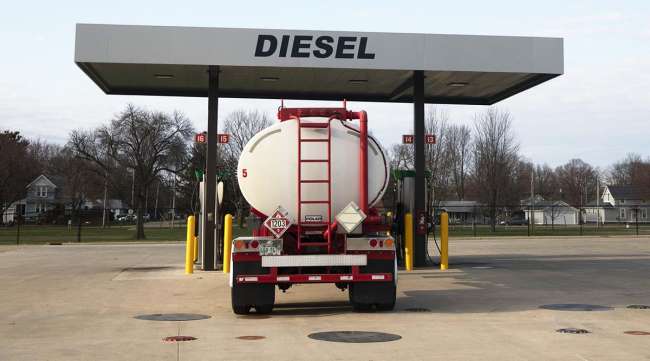Senior Reporter
Diesel Rises 2.2¢ to $2.425 as Demand Begins to Increase

[Stay on top of transportation news: Get TTNews in your inbox.]
The national average retail price of diesel rose for the third consecutive week, 2.2 cents to $2.425 a gallon, according to data the Energy Information Administration released June 22.
Even with the increase from $2.403, the price of trucking’s primary fuel is 61.8 cents a gallon less than it was a year ago.
The price increased in all 10 regions of the country surveyed by EIA. Gasoline continued its climb too, up 3.1 cents to $2.129.
U.S. average on-highway #diesel fuel price on 6/22/2020 was $2.425/gal, UP 2.2¢/gallon from 6/15/2020, DOWN 61.8¢/gallon from year ago https://t.co/4q4l1nvNXe #truckers #shippers #fuelprices pic.twitter.com/fd791RRZ4b — EIA (@EIAgov) June 23, 2020
The most expensive diesel in the nation remains in California, where the average price rose 1.9 cents a gallon to $3.237, but that still is 73.1 cents cheaper than at this time in 2019. California’s increase was about in the middle of the price hikes.
The least expensive fuel remains along the Gulf Coast, where the price increased 2.3 cents to $2.197 a gallon. The Gulf Coast is home to much of the nation’s oil and gasoline production and a large share of the refining capacity. Generally, the lower cost of transporting crude oil and refined products keeps prices substantially lower.
U.S. average price for regular-grade #gasoline on 6/22/2020 was $2.129/gal, UP 3.1¢/gallon from 6/15/2020, DOWN 52.5¢/gallon from year ago https://t.co/DiSnBg87uL #gasprices pic.twitter.com/1Vq8h7AUOi — EIA (@EIAgov) June 23, 2020
The Midwest saw the most significant jump in diesel prices, 3.3 cents to $2.289 a gallon, but that is 63.7 cents less expensive than last year. The smallest increase was in New England, where the price nudged up three-tenths of a cent to $2.631 a gallon from $2.628. In that region, diesel is 5.5 cents per gallon less expensive than a year ago.
Oil industry analyst Phil Flynn told Transport Topics that as the economy begins to gain momentum, oil prices gradually will increase, and the hikes will be felt sooner rather than later at gas stations, truck stops, and other places where cars and trucks refuel.
“I think we’re in a recovery,” Flynn said. “I think there are signs the market is tightening, and it’s a combination of the economy opening and demand getting back to normal. You’re seeing demand come back faster than anticipated.”

Flynn
Flynn also said, for now, OPEC+ nations’ decision to cut production, in addition to lower domestic oil output because of the falling price of crude from March through May, is making an impact.
Earlier this month, OPEC members and Russia agreed to extend their production cuts to reduce world oil supplies by about 10% to bring supply and demand back into line, and keep the price of a barrel of oil around $40. West Texas Intermediate, the industry benchmark, closed at $38.23 on June 23.
According to EIA, U.S. gasoline demand averaged 7.9 million barrels per day during the last days of May and into early June. That figure was up 4.6% from the previous week. However, it still was well below the 9.87 million barrels per day in the same period in 2019.
Before the pandemic, the U.S. was using an estimated 4 million barrels of diesel a day. Demand fell as low as 2.7 million barrels a day in April, when many experts believe the economy may have bottomed out. Now, diesel demand is approaching 3 million barrels daily.

COVID-19 has placed significant strain on many freight networks. So how are third-party logistics providers adapting to meet these challenges? Host Seth Clevenger chats with two 3PL executives who have had firsthand experience contending with this crisis. Hear a snippet, above, and get the full program by going to RoadSigns.TTNews.com.
While demand for gasoline and diesel is rebounding, it’s likely to be a slow climb, especially as the country continues to battle the COVID-19 pandemic, and the number of recorded cases increases in several states. That includes significant population centers, including Florida, Texas and Arizona, even as the situation is improving in once hard-hit states in the Northeast, among them New York, New Jersey and Massachusetts.
Tom Kloza, Oil Price Information Service founder and global head of energy analysis, told TT energy demand is closely tied to consumer confidence. Even with the latest increases, gasoline and diesel prices going into the Independence Day weekend will be historically low.
“This is the cheapest second quarter for Americans for energy in the 21st century,” he said. “Our second-quarter demand is going to be the lowest quarter demand number for this century. The only question will be if it goes back to the Reagan administration in the 1980s or the Carter administration in the 1970s. Oil is cheap.”
In its latest energy forecast, EIA said second-quarter worldwide petroleum demand likely would be 84.8 million barrels per day, well below the 100 million barrels of oil per day the world used last summer. For the entire year, the energy agency says consumption should average 92.5 million barrels per day, down about 7%.
Want more news? Listen to today's daily briefing:
Subscribe: Apple Podcasts | Spotify | Amazon Alexa | Google Assistant | More




